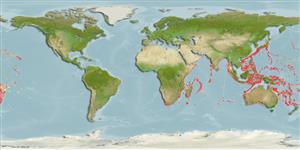Élasmobranches (requins et raies) (sharks and rays) >
Myliobatiformes (Stingrays) >
Hexatrygonidae (Sixgill stingrays)
Etymology: Hexatrygon: Greek, exa = six + Greek, trygon = the name of a ray; 1749 (Ref. 45335).
Eponymy: David ‘Dave’ Bickell was a South African journalist, formerly the angling correspondent for the ‘Eastern Province Herald’. [...] (Ref. 128868), visit book page.
Environment: milieu / climate zone / depth range / distribution range
Écologie
marin bathydémersal; profondeur 350 - 1120 m (Ref. 9906), usually 362 - 1120 m (Ref. 9906). Deep-water; 46°N - 37°S, 16°E - 154°W
Indo-Pacific: South Africa eastward to Japan, Australia and the Hawaiian Islands.
Taille / Poids / Âge
Maturity: Lm ? range ? - ? cm
Max length : 143 cm TL mâle / non sexé; (Ref. 31444); 111.7 cm TL (female)
Épines dorsales (Total) : 0. A bizarre-looking flabby stingray with a long, thick, fleshy snout (Ref. 5578). Dark violet-blue or brownish above, white below (Ref. 5578).
Inhabits soft bottoms of upper continental slopes (Ref. 9906). Feeding habits unknown (Ref. 9906). Minimum depth from Ref. 58018. Probably caught with bottom trawls (Ref. 9906). Maximum length of female from Ref. 84148.
Life cycle and mating behavior
Maturité | Reproduction | Frai | Œufs | Fécondité | Larves
Smith, M.M. and P.C. Heemstra, 1986. Hexatrygonidae. p. 142-143. In M.M. Smith and P.C. Heemstra (eds.) Smiths' sea fishes. Springer-Verlag, Berlin. (Ref. 3966)
Statut dans la liste rouge de l'IUCN (Ref. 130435: Version 2024-2)
Menace pour l'homme
Harmless
Utilisations par l'homme
Pêcheries: sans intérêt
Outils
Articles particuliers
Télécharger en XML
Sources Internet
Estimates based on models
Preferred temperature (Ref.
123201): 4.1 - 10.7, mean 6.6 °C (based on 1209 cells).
Phylogenetic diversity index (Ref.
82804): PD
50 = 1.5000 [Uniqueness, from 0.5 = low to 2.0 = high].
Bayesian length-weight: a=0.01000 (0.00244 - 0.04107), b=3.04 (2.81 - 3.27), in cm total length, based on all LWR estimates for this body shape (Ref.
93245).
Niveau trophique (Ref.
69278): 3.6 ±0.5 se; based on size and trophs of closest relatives
Résilience (Ref.
120179): Faible, temps minimum de doublement de population : 4,5 à 14 années (Assuming fecundity<100).
Fishing Vulnerability (Ref.
59153): Very high vulnerability (86 of 100).
